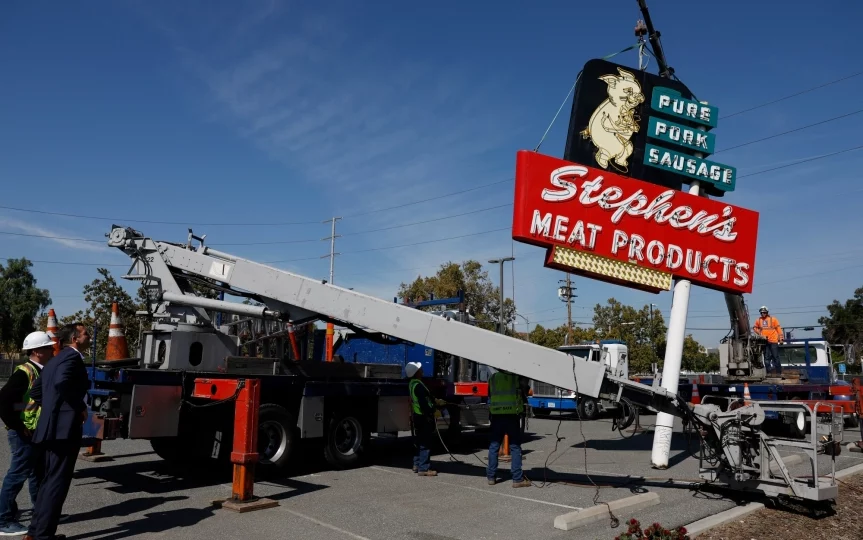
Google downtown San Jose village launches this month with demolitions
“Dancing pig” sign is being rescued and relocated to San Jose history park
SAN JOSE — In the most tangible sign to date of the coming transformation of downtown San Jose, this month Google will begin the first building demolitions ahead of the tech titan’s new urban village — but even as the community turns toward its future, a “dancing pig” that linked to the South Bay’s past will be preserved.
The Stephen’s Meat Products sign near the Diridon train station was relocated on Thursday and was being kept safe until it is re-lighted at San Jose’s History Park. Eventually, it will be preserved as a permanent part of Google’s neighborhood, called Downtown West.
The salvage and preservation of the familiar sign is a very visible move to mark the start of Google’s proposed mixed-use neighborhood. Even so, other crucial endeavors beginning this month will be the first major steps in the development.
Google sketched out a demolition timetable that begins in mid-October and ends fewer than four months later, sometime in January 2023.
“What Google is launching today will be transformational for our city for decades,” San Jose Mayor Sam Liccardo said in an interview with this news organization at the Downtown West site on Thursday.
The search giant’s new neighborhood has been in the works for about six years, starting with Google’s $55 million purchase — using the nondescript name of “Rhyolite Enterprises” as an alias — of the Sunlite Bakery Bread Depot in late 2016. When fully built out, the village will bring up to 25,000 Google jobs, millions of square feet of new office space and thousands of homes, including hundreds of affordable residences, to a sleepy section of downtown San Jose.
“We remain focused on the site preparation and infrastructure improvements needed to support the development of the Downtown West project,” said Sheela Jivan, a Google spokesperson.
On Oct. 17, demolition is slated to begin at four locations and multiple buildings on South Montgomery Street and the adjacent Otterson Street. The work will be completed by no later than the end of January, according to Google’s information.
“The site is rich with history, and part of this work is the careful management of historic resources, including Stephen’s Meat ‘Dancing Pig’ sign,” Jivan said.
The well-known sign is slated to reappear within the next several weeks at San Jose’s History Park on Phelan Avenue. The sign will be re-lighted at the history center in Kelley Park. Eventually, a few years from now, the sign is expected to return to the Downtown West neighborhood.
“The Dancing Pig is not being made a refugee by this development,” Liccardo said. “The pig will dance again.”
The sign had been at this site since the 1950s when the meat plant opened. The meat-products building was torn down around 2007, but the sign, a piece of local culture, remained.
“We really like Google’s commitment that this sign is an asset,” said Ben Leech, executive director of the Preservation Action Council of San Jose. “The sign will be kept visible. It’s not just going to be hidden away in a warehouse.”
The buildings that will be demolished have addresses of 140, 145 and 102 S. Montgomery St. and 327 Otterson St.
The properties slated to be bulldozed are known as the Sunlite Bakery Bread Depot, the former Patty’s Inn drinking establishment and an old Airgas store. A building next to the Airgas outlet is also headed for demolition.
In a further sign that Google will preserve some key components of the development, the company aims to use the Art Moderne-style entrance of the old bakery building somewhere in the transit village project.
The tech titan also will rescue other key historic elements in the Downtown West footprint, including parts of an old foundry near the SAP Center.
Google plans to break ground on Downtown West in 2023.
The neighborhood will include up to 7.3 million square feet of offices, 4,000 residential units, 500,000 square feet of retail space such as shops and restaurants, 300 hotel rooms and 15 acres of open space. Google is expected to employ up to 25,000 people in the transit village.
“Google’s development will be the biggest thing to happen to any central business district in the United States,” Mark Ritchie, president of Ritchie Commercial, a real estate firm. “It will nearly double the amount of office space that now exists in downtown San Jose.”
The tech company has engaged in “thousands of touchpoints” with the community, which has resulted in feedback that Google describes as very positive and useful.
“Downtown West is being built adjacent to not just a transit center but existing vibrant neighborhoods,” said Bob Staedler, a consultant for Stakeholders + Neighborhoods Initiative, a non-profit neighborhood group. “The success of Downtown West will not be measured in square footage built but by how it implements the themes from the thousands of touchpoints from the community.”
In May 2022, Google completed an early payment of $7.5 million in a community-benefits payment made to the city of San Jose. The company will pay the rest of the public benefits as the Downtown West development proceeds. All told, the community benefits package totals $200 million.
“We look forward to continuing our work with the city and community as we make progress,” Jivan said.
In a reminder of the long-running effort behind the Downtown West project, it was nearly six years ago, in December 2016, that Google bought the first of the properties it would need for the development. That initial purchase was the old bakery building, located just south of the dancing pig sign site.
“We are really seeing forward motion with this project now,” Liccardo said.
Full article by George Avalos: https://www.mercurynews.com/2022/10/06/google-downtown-san-jose-village-tech-transit-real-estate-office-home/

